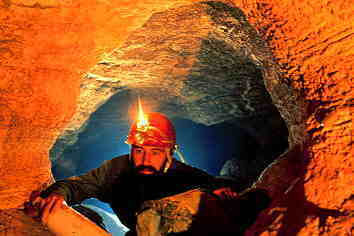
Description
Geology | Geography | Ecology
Map of the cave
Facilities
Research facilities in the area
Conservation
Custodians | Legal status
Research
Papers | Projects | Institutions
People|Programs|Reprints
Contacts
Contact the custodians
Related links
Site map
Overview of the site
Discovery
While excavating for a major construction project in 1986, engineers happened to find a cave in which extraordinary conditions prevail. Named the Movile cave, it is the site of a hitherto unknown groundwater ecosystem that is rich in hydrogen sulfide (8-12 mg/l) and in contact with an atmosphere poor in oxygen (7-10%), rich in carbon dioxide (2-3.5%), and also containing significant amounts of methane (1-2%). Its exploration began in 1990.
 |
Until research teams began exploring Movile Cave, its 12000 square meters were entirely sealed off. The cave had no natural entrance and was discovered by accident during some geological research in the area. |
The cave is located near the city of Mangalia, in the southeastern part of Romania, only few kilometers far from the Black Sea.
The entrance is represented by a shaft with a depth of 18 meters.

With a total length of about 300 meters it is a relatively small cave with narrow passages covered with clay. It is developed mainly horizontal with some pits which do not exceed 3 meters.
In its lower part there is a small lake which connects the cave with the groundwater table. The passages continue underwater and are forming 3 air bells where the atmosphere is very rich in carbondioxide (up to ten times more than outside) and poor in oxygen (one third of the outside atmosphere).
(see also the species list)
When Earth's climate changed 5.5 million years ago, the area went from being tropical to temperate. The only animals that survived were those living in warm caves underground.
Movile Cave, is one of Earth's most unusual ecosystems, populated with invertebrates that have adapted -- through a process called troglomorphy -- to their underground prison. They have done this by:
- Losing pigmentation
- Learning to navigate blind
- Surviving on bacteria and fungi that derive energy from the sulfide hot springs beneath the cave.
The predatory leeches, rare water scorpions, and other inhabitants of Movile Cave are similar to species found in deep sea vent communities. They depend on chemoautotrophic organisms (users of chemical energy) instead of the more usual photoautotrophic organisms (users of photosynthetic energy).
 |
Forty-six species of terrestrial and aquatic invertebrates have thus far been identified to inhabit this ecosystem, of which 31 are of a previously unknown kind. |
The vast majority are anthropods belonging to the classes of Arachnida, Crustacea, Myriapoda, and Insecta. Eighteen aquatic species in the cave belong to the phyla Plathelminthes (flatworms), Nematoda (round worms), Rotifera (microscopic animals related to round worms), Annelida (segmented worms), etc. A blind leech, a snail, and a blind water-scorpion have also been identified.
The discoveries include grazers such as four species of isopods, or pillbugs, six springtails, a millipede, and a bristletail. Among the new species of carnivores are two pseudoscorpions, a 2-inch-long centipede, a worm-sucking leech, four spiders, and a water scorpion.